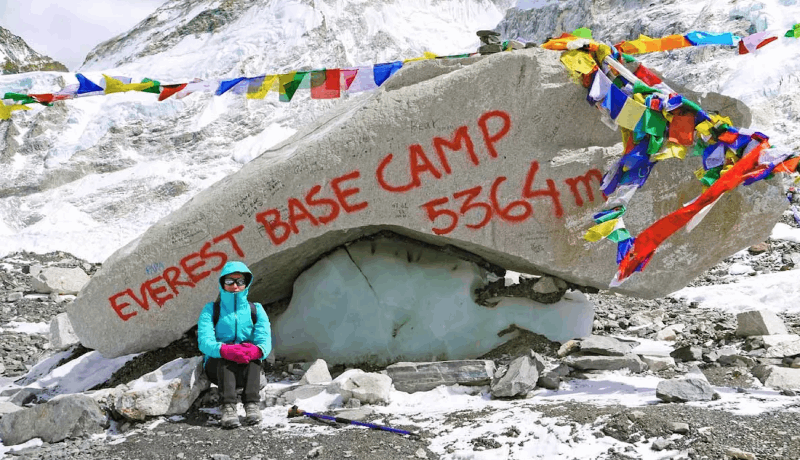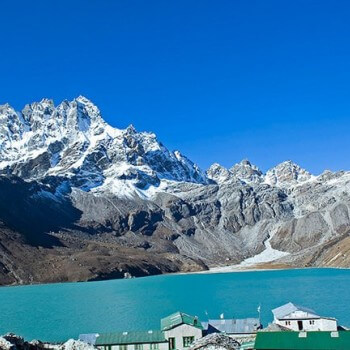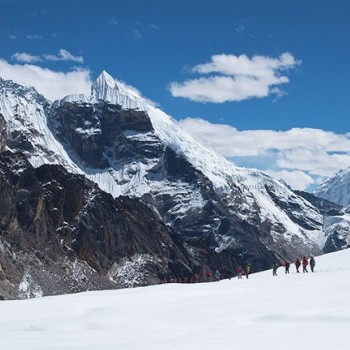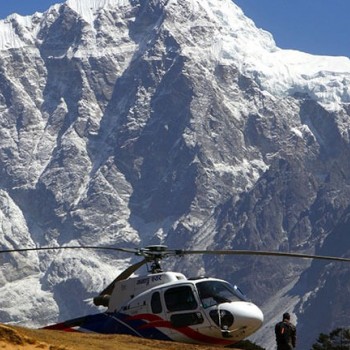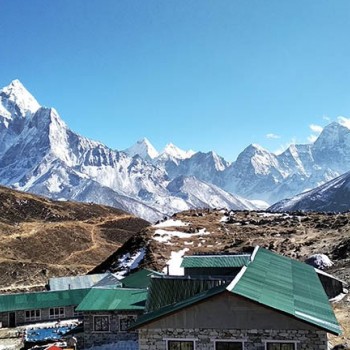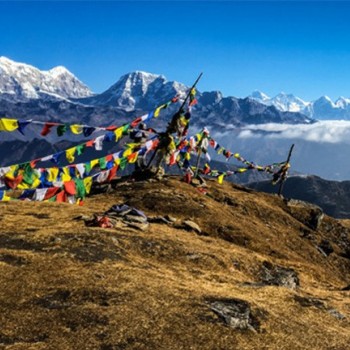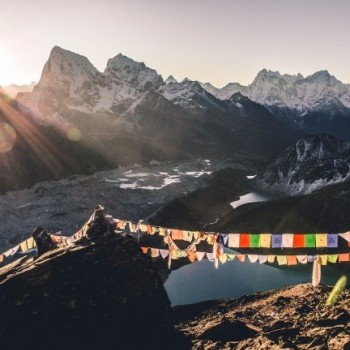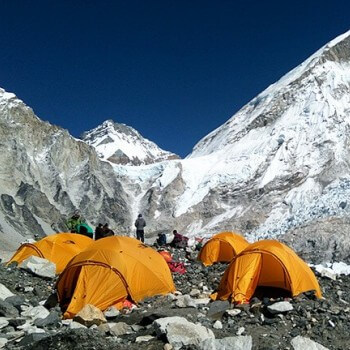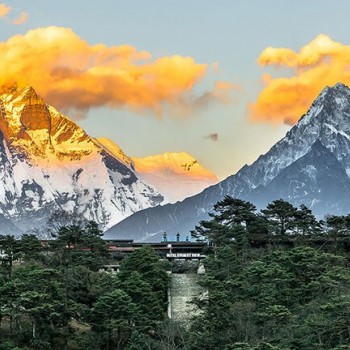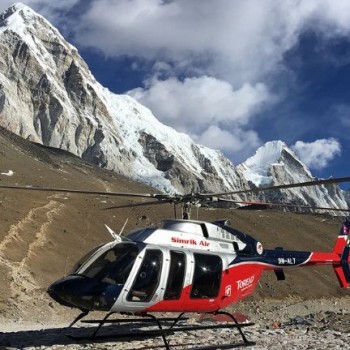Trip Details
- Destination: Nepal
- Trip Difficulty: Moderate
- Trip Style: Trekking
- Transport: Private Vehicle & Flight
- Accommodation: Teahouse or Lodge
- Group Size: 2-16
- Max Elevation: 5545M
Highlights
- Scenic flight above the mountains.
- Explore UNESCO World Heritage Sites (Pashupatinath, Boudhanath, Swayambhunath).
- Explore Sherpa Culture at Namche Bazar.
- Spectacular views of Khumbu Icefall.
- Hike to Kala Pathar (5,555m).
- Visit Tengboche Monastery.
- Hike to Nangkartshang Peak (5,083m).
- Trek to Everest Base Camp.
- Trek to Khumbu Glacier.
- Closure to the world’s highest mountain, Mount Everest (8,848m)
Description
Everest Base Camp Trek is a famous trekking destination. It is a mesmerizing experience to the world’s highest mountain Mount Everest (8848) giving a sensational challenge for all adventure lovers. Everest Base Camp trek offers spectacular panoramas and charming of the mountains. Most trekkers regard it as the most exciting trekking expedition in Nepal.
Everest Base Camp Trek by Mount Mania starts at Phakding. The trail then follows the Dudh Kosi valley. The Everest Base camp trek continues uphill as you get to Namche Bazar. Namche Bazar is also known as the Sherpa capital. It is a junction for trekkers where you can also buy some trekking gear if you want to.
You will hike along with magnificent forests of rhododendron. The trail is also intercepted by magnolia and giant firs. As you do so, you will also get to see the various flora and fauna unique to this region. As most of the trekking region lies within the confines of Sagarmatha National Park, this place still retains much of its natural beauty.
As you trek further up, you will get to see various places like Tengboche, Dingboche, Lobuche, and Gorak Shep. All of these picturesque villages have delightful spots that give you wonderful mountainous views. The stay at Tengboche is especially delightful as you will visit the Tengboche Monastery.
The monastery is the largest in the Everest region. The festival of Mani Rimdu which falls in the autumn season gives you great insights into the Tibetan Buddhism of this region. Great views of the towering mountains like Everest, Nuptse, Ama Dablam, etc surround this monastery.
The trail reaches the highest point of the expedition at Kala Patthar (5555m). Everest Base Camp Trek takes you on a wild ride. But the 360-degree panorama views of Everest (8848), Lhotse(8516m), Nuptse(7861m), Kantega(6782m) and Ama Dablam(6170m) adds spiritual feeling to the hike. Which makes the Everest Base Camp tranquil and inspiring places in the world.
Everest Base Camp takes you closer to Mount Everest. You will also have surprisingly good views of the Khumbu Glacier and the Ngozumpa glacier during this trek. All in all, Mount Mania gives you a wonderful exploration of the Everest Base Camp during this 14 days Everest Base Camp Trek.
12 Days Everest Base Camp Trek For Indian Citizen Itinerary
Hide AllDay 1: Flight from Kathmandu to Lukla. Trek to Phakding (Hotel Sherpa)
This day, you will take a morning flight to Lukla. This flight will give you glimpses of the mountains of the Everest region. This is a short flight that lasts 25 minutes long. When you land in Lukla, you’ll greet your guide and porter. After having a short break in Lukla, you will start your trek.
Firstly, the trek to Chaurikharka village is quite easy. Then, you will make a descent towards Thadokoshi to Ghat (2,530m). The trail follows the bank of the Dudh Koshi River until you reach Phakding (2,652m). The trek to Phakding(2650 meters) from Luka is 3-4 hours long. You will have your overnight stay in the beautiful village of Phakding. You can enjoy the view and vibe of this wonderful little village.
Day 2: Trek to Namche Bazaar (Comfort Inn)
After breakfast in Phakding, you will be gearing up for the trek to Namche Bazaar (3440 meters). It is the biggest Sherpa village in Nepal. Our trail takes us first over the Dudh Koshi River via a long suspension bridge, and then through a beautiful pine forest to Monjo. We will enter to Sagarmatha National Park for a brief permit check. After the respective officials have checked your permit, you will descend to Dudh Kosi River and reach Jorsale.
We will stop to Jorsale for the Lunch and then depart to Namche. Your trek exists of crossing one of the highest bridges in Khumbu Region, known as Hillary Suspension Bridge. From Top Danda, you will see the first glimpse of Mount Everest. After one hour of trekking, you will reach your final destination of the day- Namche Bazaar. The trek to Namche Bazaar from Phakding is 5-6 hours long. Namche Bazaar is said to be the only gateway to Everest.
Day 3: Day Hike in Namche Bazaar (Comfort Inn)
This day, you will hike to Everest View Hotel (3880m) from Namche Bazar. You will be able to experience the beautiful landscape of Mt. Everest, Mt. Lhotse, Mt. Nuptse, Mt. Amadablam and other mountains. This hike will help in speed acclimatization for trekking to Everest Base Camp.
Also, you can check out the Sherpa museum for an overview of the Sherpa culture and history of mountaineering.
On Saturdays, the Hatt Bazaar is open for trading and an intimate look at the locals’ marketplace. It is part of the larger Namche Bazaar shopping hub. It is full of trekking and mountaineering clothing and gears. Namche Bazaar is the last stop for exchanging foreign currency and withdrawing money from ATM.
Day 4: Trek to Tengboche (Tashi Dele)
After Breakfast in Namche Bazaar, you will prepare yourself with proper trekking gears to trek Everest Base Camp. You can enjoy the breathtaking views of the Himalayas. Everest, Nuptse, Lhotse, Ama Dablam, Thamserku, and Kwangde – are some of the highlights you don’t want to miss.
A short drop takes you to the riverside and then cross the river upwards through the forest pass. Continual uphill trek between a gradual grade and some seriously steep ground may make your trek challenging. After trekking for 5 hours, you will reach Tengboche (3876 meters). We’ll stop in the Tengboche monastery, one of the largest monasteries in Khumbu. Chanting and prayer from the resident Buddhist monks are bound to give you inner peace and refreshment for the rest of your trek.
Day 5: Trek to Dingboche (Goodluck Hotel)
After hot breakfast in Tengboche, your trek will start through the rhododendron forest to Deboche. This will be followed by a bridge over the raging ‘Imja Khola’ River. You will then pass the valley before crossing the last suspension bridge for Everest Base Camp Trek. We will trek toward Pangboche village, which is one of the biggest settlement of Sherpas in the region. Here, you will get to enjoy a great opportunity to observe a typical Sherpa village and have lunch.
You can also hike to the Pangboche monastery, which is one of the oldest monasteries in the area. After hiking to Pangboche, you will be heading towards a wide valley. This valley has a dry atmosphere and deserted mountains. Finally, after trekking for 5-6 hours, you will reach your overnight stop at Dingboche (4410 meters).
Day 6: Day Hike in Dingboche (Goodluck Hotel)
Accimilitization in Dingboche is a beautiful opportunity to spend some quality time in this village of remarkable landscape views. You can utilize your day by exploring Dingboche and hiking up to Nagarjuna Hill (5083m). From Nagarjuna hill, you can enjoy the beauty of Island Peak Summit, Mt. Makalu, Mt. Amadablam, Lobuche Peak, Glacier Lake, Amphu Laptsa, and Makalu Barun National Park. After getting back from a day hike, you will have your lunch at a teahouse and take a rest. If you have any clothes to wash, then you can do it during your leisure time after lunch.
Day 7: Trek to Lobuche (Alpine Hotel)
After breakfast in Dingboche, the trek will move gradually and be more challenging due to the higher altitude. You’ll pass Thukla with a tough steep walk to the high of a hill. There you will find some memorial stupas dedicated to the climbers and trekkers who lost their lives while trying to get to the top of Mt. Everest over the years.
The next part of our adventure brings you over a rocky mountain landscape to Lobuche. Lobuche is quaint little settlement with amazing views of Mt. Lobuche, Mt. Pumori and the Nuptse. You need to keep yourself warm and be fully prepared for freezing cold because we are now almost at 5000m above sea level. Lobuche stands at an altitude of 4930 meters.
Today’s trek is quite pleasant as it is 2-4 hours long. This short trek will help you get plenty of rest before heading out to Everest Base Camp the next day.
Day 8: Trek to Gorak Shep and visit Everest Base Camp (Snowland)
After a breezy cold morning with warm breakfast, you will head to your final destination for Everest Base Camp (5364 meters). On the way to your destination, you’ll come closer to the famed Khumbu Glacier and icefall. The icefall lies on the slopes of Everest. During the spring season, you will meet climbers attempting to scale the mountain’s summit.
Don’t forget to take out your cameras to capture mesmerizing views of majestic mountains. After enjoying the sunset, you’ll head back to Gorak Shep (5180 meters) for rest. We will overnight at Gorak Shep because of high altitude and low temperature at Everest Base Camp.
Day 9: Trek to Kala Patthar and back to Pheriche (Himalayan)
Today, we will wake up before sunrise to trek towards Kalapathar (black rock). Kala Patthar lies at an altitude of 5545 meters. The day’s first light will illuminate your spectacular view of Nuptse Nup, Changtse, and Lhotse. Kalapathar is one of the best viewpoints of Everest and its region. It is also the highest point that you can be during this trip.
You can capture amazing pictures of mainly Khumbu Glacier and Mt. Everest. After capturing some amazing pictures you’ll be heading back to Gorak Shep for breakfast. After breakfast, you will trudge down and set off to your overnight stop at Pheriche. As you trek down to Pheriche, you will lose an altitude of around 1300 meters. The total duration of today’s trek is 7-8 hours.
Day 10: Trek to Namche Bazaar (Comfort Inn)
After breakfast in Pheriche, we will head to Tengboche which is mainly downhill. After having lunch in Tengboche, you will ascend to Kyangjuma. The trek from Kyangjuma to Namche is quite easy. After trekking mostly downhill and losing almost 800 meters in altitude along the way, you will reach the capital of Sherpas i.e Namche Bazaar. After a healthy trek of 6-7 hours, you will reach your teahouse in Namche for your overnight stay.
Day 11: Trek to Lukla (Khumbu Resort)
After breakfast, we will trek towards the Hillary Suspension Bridge and then pass through several local villages. Till evening, you will be able to reach Lukla. The trek to Lukla from Namche is 6-7 hours long. Further, you will lose an altitude of around 600 meters today. You will celebrate the victory of completing the trek if you want to. Today will also be your last day in the Everest region. You can have a farewell dinner with your porter and guide today.
Day 12: Flight from Lukla to Kathmandu
After early breakfast in Lukla, we will take a 30-minute flight back to Kathmandu. This will also mark the end of the journey. You can also have some delightful sight of the landscapes of mountains of the Everest region during your flight. After landing at Kathmandu airport, you will directly go to the hotel where you will spend your night. One of the Mount Mania representatives will invite you to attend a farewell dinner with a cultural show.
What to Expect
Cost Includes
- Airport Pickup and Drop (Domestic & International)
- Teahouse Accommodation during the trek
- Round Trip Domestic Flight (Kathmandu and Lukla)
- English Speaking Trekking Guide with Food & Accommodation, Insurance, and Transportation
- All Trekking Permits (Sagarmatha National Park Entry Fee, TIMS Card, and Khumbu Pasang Lhamu Rural Municipality Fee)
- A first aid kit carried by the guide (Oximeter to measure your oxygen and pulse in high altitude)
- Use of sleeping bag & Duffel bag (if you don’t have your own, To be return after trip completed)
- All Government and Local taxes
Cost Excludes
- International Flight Ticket and Nepalese Visa Fee
- Hotel & Meals in Kathmandu
- Meals In Trekking
- Extra Baggage Charges
- Extra night accommodation in Kathmandu in case of early arrival, late departure, and early return from the trek (due to any reason) than the scheduled itinerary
- Personal expenses (WiFi, Phone calls, Laundry, Bar bills, Battery Recharge, Water, Shower, and Tea / Coffee)
- Other costs not mentioned in 'Cost Includes' section
- Travel and Rescue Insurance
- Tips for Guides and Porters
Optional
- Helicopter Flight Kathmandu to LUkla $350 Per Person
- Helicopter Flight Lukla to Kathmandu $350 Per Person
- 3 Star Hotel in Kathmandu Twin Sharing on BB USD 60$ Per Night
Useful Information
Best Time for Everest Base Camp Trek
If you like the busy hum of trekking trails, then spring (March, April, and May) and autumn (September, October, and November) will be the best time for you to trek to Everest Base Camp. These seasons also have the best trekking weather and climatic conditions.
If you are looking for some quiet and some off-season discount on your trek, then winter (December, January, and February) will be the best season for you. However, there might be chances of snowfall interrupting your trek this season.
Summer (June, July, and August) will be quite wet with chances of flight cancellations. However, if you can make arrangements for your delay, you can enjoy the EBC trek in the summer season too.
Everest Base Camp Trek Difficulty
Everest Base Camp Trek is a moderately difficult trek. This trek lasts 14 days. This trek takes you to the highest point of Kala Patthar, which lies at an altitude of 5545 meters. You will have to prepare well physically in order to adjust to the high altitude of this region.
So preparation of a couple of months before you come to complete the Everest Base Camp Trek is necessary. You can prepare in a lot of ways including aerobic exercises, strength training, or taking a few preparatory hikes before coming to this trek.
Everest Base Camp Trek Weather
In case of bad weather in the Himalayas, which may lead to flight cancellation, the guide will explain to you about a contingency plan for this trip upon arrival in Kathmandu
FAQs
What is Trekking, and how it is different than Hiking and Climbing?
Trekking is an activity of walking the natural landscapes (especially the side of the mountain) with a specific purpose of exploring and enjoying the scenery. Trekking is generally a multi-day walk, where you stay overnight at trails.
It tests the trekker's physical ability, stamina, endurance, and also the psychological capacity. Trekking is different from hiking as trekking is a rigorous and challenging activity, whereas hiking is mainly a leisure activity. Hiking generally ranges from a single day walk.
Climbing, on the other hand, is a much more challenging that requires various technical skills like abseiling, rope fixing, among others. A climber is much riskier requires specialized equipment, as well as rigorous training.
How many hours should I walk daily?
The trekking hours depend upon the trekking routes you choose. In general, a trek like Everest Base Camp, Annapurna Circuit, Manaslu Circuit, Annapurna Base Camp, Kanchenjunga treks requires five to six hours of walking on average. The duration also depends on your pace too.
It is not advisable to trek more than 600m altitude in a day. Starting your trek early is key to avoiding the midday heat and arriving at your destination early. This leaves you enough time to rest, acclimatize, and explore the region.
How difficult is trekking in Nepal?
The level of difficulty depends on the trekking route such as Everest region treks, Annapurna region treks, and other remote area treks. It is also subjective to each individual and their level of endurance. A basic level of fitness is necessary to trek the high altitude region of Nepal with considerably challenging trails.
Also Read: Manaslu Circuit Trek Difficulty
Some regular exercise, including cardiovascular activities including but not limited to hiking, cycling, swimming, is a must. Trekkers must have a healthy heart, lungs, and joints. You must start the training regime at least two weeks before the trek.
Is Trekking recommended for all age groups of travelers?
Trekking in Nepal is ideal for all age groups. Trekking can be fun for children as well as for people in their seventies. You can choose the trek based on the difficulty level and suitability.
However, with children, you need to be extra careful in the high altitude regions as they cannot express their pain and fatigue properly. For older people, treks can get customized with accommodating enough rest, acclimatization, and cultural exploration.
You can opt for Ghorepani Poon Hill trek, as it is one of the most popular easy treks in Nepal. This trek is suitable for all age groups with children and family as well.
Also Read: Top 10 Best Short Treks in Nepal
What is the minimum duration for trekking?
The minimum duration of trekking depends upon the trek destination and trail type. There are many treks that last around 3-8 days.
These treks are short and specially designed for beginners. The trek journey can get modified by increasing or decreasing the rest and acclimatization days.
Do I need to get some training before doing trekking in Nepal?
Yes, it's better to get some training before doin trekking in Nepal. The training should consist of practice hikes, cardiovascular endurance (aerobic exercise), strength training, and mental strength exercises.
What are the basic tips for beginner trekkers who don’t have any experience?
The essential tips for beginners trekkers who don't have any experience are:
- Walk at a slow but steady pace
- Do not rush in your trek
- Acclimatize and hydrate regularly
- Pack all your necessities properly
- Start early on your trek
- Pre-book your trip
How safe is the water to drink?
The tap water in Nepal is unsafe to drink. The trekkers need to boil their water, use water purification tablets, or bottled water. In high altitude conditions, you need to boil water longer than at lower elevations.
If you choose to carry or buy bottled water, you should always check if the bottle cap is properly sealed and not tampered. Water purification tablets and drops like Piyush, Water guard use chlorine solution to purify waters.
You can use any of these methods and drink lots of water to reduce dehydration and cope with altitude sickness.
Where are we staying each night during trekking?
Nepal is famous for the teahouse treks. There are tea houses, lodges, guest houses all along the trails. You will stay at these accommodations each night on your trekking adventure.
These accommodation facilities provide twin beds, a pillow, and a warm fuzzy blanket. You might find it challenging to find proper accommodation facilities along with the remote off the beaten treks. You might have to camp in such conditions.
What is Teahouse Trekking Nepal?
The teahouses trekking means staying in a teahouse or lodge every night in your trekking journey. The tea houses offer necessary facilities of lodging and meal and allow trekkers to carry a minimum amount of gear.
A teahouse can range from comfortable lodges, like in the Solu Khumbu region to a small bamboo hut in the remote trails of western Nepal.
Which are the permits required for trekking? Can I apply as an individual?
A TIMS (Trekkers’ Information Management Systems) card is a necessary trekking permit required for any trekking activity in Nepal. Besides that, you will need area-specific trekking permits at varied costs based on the region.
For example, you will need an ACAP (Annapurna Conservation Area Permit) if you want to do the Annapurna Circuit trek permit and a Sagarmatha National park permit for the EBC trek. You can get the TIMS card and other area-specific permits at the office of the Nepal Tourism Board office in Kathmandu.
Is Travel Insurance compulsory while you travel to Nepal?
Yes, travel insurance is compulsory for all travelers traveling to the region. You must get an excellent travel insurance package that covers both the medical and emergency evacuation cost. A travel insurance package of a minimum of USD 100,000 is ideal.
What if I get sick in the mountains?
When trekking in the remote mountain areas, you will only get elementary medical facilities available or none at all. You can find the Himalayan Rescue Association (HRA) health posts run by western volunteer doctors at Pheriche and Manang in the Everest and Annapurna region, respectively.
The doctors provide consultation and services if necessary. If you get severely ill or accidents, then you might as well need a helicopter evacuation back to Kathmandu or Pokhara.
How high is the chance to get altitude sickness? How will a guide help?
The chance to get altitude sickness is exceptionally high in these Himalayan regions. A guide will help you to acclimatize appropriately, which is a crucial step to avoid altitude sickness. The guide can also help you to recover in case you get altitude sickness or with any emergencies.
How to avoid altitude sickness?
The primary key to avoid altitude sickness is to acclimatize properly. You should not gain more than 600m in altitude in the high altitude regions. Expert trekkers advise to take it slow and not to trek in a rush.
Regular hydration with at least 5 liters of water is a must. You can also take precautionary tablets under the supervision of a medical professional if needed.
Why is the domestic flight specially to and from Lukla or Jomsom delayed?
The domestic flight to and from Lukla gets delayed frequently due to unfavorable weather conditions. The weather around the high altitude regions is quite unpredictable.
Lukla airport is also one of the smallest airports in the world. The short runway means that multiple flights cannot land at the same time and can even cause unwanted delays.
Who will carry my backpack?
You can hire a porter for the high altitude trek. They will carry all your luggage that might include your trekking and sleeping equipment. Hiring a porter significantly reduces the weight off your back.
You can carry a light daypack consisting of water, a camera, snacks, and rain gear. The heavy luggage will get carried by a porter. Some guides work as porters, as well.
What are the food items that we can eat in the teahouse?
For breakfast, the tea houses provide a regular bread toast along with hot tea or coffee. For lunch and dinner, the staple dish of “Dal Bhat” gets served on the tea houses. The Dal Bhat is highly nutritious, with a balance of carbohydrates and protein.
It consists of if rice, cereal, vegetables, lentils, spinach, meat, and pickles. Some tea houses do serve a limited variety of western cuisines like pizza, burgers, and pasta, as well.
What are the services that we get from each teahouse?
The tea houses provide lodging and meal facilities. They provide a twin bedroom with a pillow and a fuzzy blanket. You will have to share a shared bathroom with fellow trekkers. The toilets are generally of squat style.
Besides that, you will get all the meal facilities in the tea houses as well. You can get all the meals of the day i.e. breakfast, lunch, and dinner in the tea houses. The food might not be fancy but provides you with excellent nutrition and adequate energy for the trek.
How safe is Nepal for solo woman traveler?
Nepal is generally safe for women travelers. The Nepalese society is quite conservative and has a specific idea of modest clothing. Dressing modestly by covering thighs and shoulders will save you from unwanted gaze on the streets.
Female travelers should not travel alone, especially at late nights. You should also choose your guide wisely after a thorough background check. If you keep these things in your mind, you will remain safe while traveling in Nepal.
How much money should I bring for trekking?
A general estimate of $25 per day per person on average would be enough for trekking in Nepal. The food and accommodation costs are generally paid upfront and costs around $2 - $3 per bed. This also includes the food costs that are available provided in the teahouses.
If you wish to take hot water showers or recharge electronic gadgets, it might cost you a couple of bucks more. If you are a budget traveler, spending frugally might get the costs down to $15. Overall, the rough estimate of $25 is ideal for the trek.
Are there any ATMs on the way to trekking routes?
There are no ATMs along the trail in the high altitude region. The last ATM can is in Namche and Lukla if you are trekking the Everest Base Camp region. You will have to use the ATM in Kathmandu and Pokhara and carry the necessary cash along with you in the trek.
How much weight can one porter carry?
A porter generally carries 10kg per client, and they carry for two clients, which means they can carry a maximum of 20kg. However, it is advisable to reduce the amount of luggage and only take the necessary ones.
How many tips should we give to guide and porter?
The general unwritten but widely followed rule is to tip 15 percent of the total cost spent trekking. If you are trekking solo, the rule of thumb is to tip $5 per day or equivalent for guides and $2 to $4 per day or equivalent for porters.
For group trekking, you can tip $10 per day for guides and $5 per day for porters. You can also tip as you wish based on the weight carried and the service provided.
What are the best seasons for trekking in Nepal?
The best time for trekking is the Spring (March to May) and Autumn (September to November). During spring, wildflowers, including rhododendrons bloom all over the trails. The clear skies and stable weather is the major attraction of the trek.
The autumn months of September to November is famous for its soothing climate and favorable temperatures. In addition to these perks, autumn is also a festive season with vibrant festivals Dashain and Tihar falling at this time of the year.
The monsoon and the winters are generally avoided because of the risks and the challenges.
Also Read: Best Time to Visit Nepal
What are the basic criteria for physical fitness?
Many people assume that they need to have an athletic strength to complete treks in Nepal, which is not true. A basic level of fitness with good stamina can easily lead you to success in the trails of Nepal.
Some cardio (aerobic) exercises, including hiking, cycling, swimming, tai chi, etc. can help you gain fitness before the start of your trek. One important thing to consider is that the treks are not a race, so you need to maintain a gentle pace with sufficient breaks and acclimatization.
If your fitness levels are on the higher side, you will enjoy the treks more and find more energy for extra activities.
Can I do trekking solo without a guide and porter?
Yes, you can trek solo in Nepal without a guide or a porter on many routes. If you come well prepared with a map or traveling a well-trodden path, you can trek pleasantly in solitude.
However, some restricted trails like Manaslu Circuit Trek do require a guide by compulsion. But there are risks of traveling without a guide mostly related to health issues and freak weather conditions.
Also Read: Manaslu Circuit Trek Without Guide
Can you list out the packing list for trekking?
The packing list for trekking in Nepal are as follows:
Clothing
- Trekking pants and jackets
- Rainproof pants and jackets
- Thermals underwear
- Pair of Gloves
- Short-sleeved trekking shirts
- Long-sleeved trekking shirts
- Woolen cap/ beanies
- Insulating jackets
- fleece-lined jacket
- Lightweight Sweaters
- Trekking boots
First Aid
- Band-aids
- Anti-nausea Medicines
- Sanitary pads/ Tampons
- Mosquito repellent spray or ointment
Toiletries
- Toilet Paper
- Shampoo
- Soap
- Sunscreen
- Hand sanitizer
Accessories
- Cameras
- Water Bottle
- Sleeping bag
- Sunglasses
- Chargers
- Extra Batteries
Important Documents
- Passport
- Photo
- Travel Permits
Can I recharge my camera batteries, phone, and other electronic batteries?
Yes, there are facilities for charging electronic gadgets like cameras, phones, and other electric batteries at an added cost. However, the charges are on the higher side, and charging time gets limited. Hence, carrying a solar-powered charger or power bank is a good option.
Can I get trekking gears and equipment on rent?
Yes, you can get any trekking gears and equipment on rent. The famous street of Thamel in Kathmandu is popularly known as “backpacker’s alley.” You can get all kinds of trekking gears and equipment, including sleeping bags, down jackets, trekking boots, for rent.
There are many gears of knock-off brands that work surprisingly well. But you should always stay away from substandard stuff that might cause you nuisance along the trek.
Is laundry services available in teahouse?
There are a few laundry services available in places like Namche. However, in the high altitude region, these facilities get scarce. You will have to wash your clothes on your own in the sink. You can use a small amount of warm water to wash your clothes.
What is the weather like in Nepal?
There are five distinct seasons in Nepal. The summers are hot and wet, and the monsoons are wet with chances of landslides. The winters are cold with freezing temperatures in the high mountains. These seasons are not the best time to trek the region.
The peak trekking seasons in Nepal are the autumn and the spring season. The autumn months come after the monsoon, and thus trekkers can enjoy the stable weather with perfect trekking temperatures.
The spring is when the trails look its best. The beautiful wildflowers, including rhododendron bloom all over the trails and the scenic environment, makes the trek quite pleasant.
What types of trekking shoes or boots do I need to bring?
You will require waterproof, sturdy hiking boots for trekking the Himalayas in Nepal. There are various shops in and around Thamel in Kathmandu that lets you buy or rent specialized trekking shoes.
Trekkers do not necessarily require crampons, but if you are trekking on a snowy trail, crampons fitted trekking boots helps you get past the snow with ease.
How will the travel company solve the problem in case of an emergency?
The guides and porters are adequately trained and skilled in handling emergencies. The travel agency is in communication with the team leader at all times through a mobile or a satellite phone.
You will get immediate first aid and all necessary help if required. Helicopters are at standby positions in case the conditions get worse, and you need an emergency helicopter evacuation.
Are there any other outdoor activities besides trekking in Nepal?
Nepal is an adventure-lovers delight. There are many outdoor activities, including bungee jumping, paragliding, zip-lining, rafting, rock climbing, canoeing, jungle safari, and others in Nepal. You can choose the best one according to your desire and schedule.
How expensive or costly is to do trekking?
While the cost may vary according to the trails, in general, the cost of trekking ranges around $1000-$2500 on average, excluding the international flight costs. This cost includes food, accommodation, permits, guide/porter, and other fees.
Which were the trekking routes damaged by an earthquake in 2015?
The popular routes Annapurna Base Camp trek and the Everest Base Camp trek was not much affected by the earthquake in 2015. However, the pristine Langtang and Manalsu trekking region were severely affected.
The landslide after the earthquake swept away many teahouses in the Langtang region, and more than 300 lives were lost. The quick rebuilding process led by the local community ensured that all the trekking routes get restored and repaired immediately.
These trails are safer than ever for a trekking adventure. Trekking has since resumed in the Langtang region.
Where the most popular places to do trekking in Nepal?
There are many trekking trails in Nepal. Some of the famous trekking trails include the Everest Base Camp Trek in the Everest region. The Annapurna Circuit trek in the tranquil Annapurna region is also quite popular.
The Upper Mustang trek, Manaslu trek, Langtang trek are also quite popular. Besides these, many off the beaten trekking routes are gaining popularity as well.
Does my guide carry a simple medical kit for general treatment?
Yes, the professional guides do carry a simple medical/ first aid kits. They are well trained and are adept at performing simple first aid if necessary. However, if the condition worsens, you will need professional medical help or even evacuation.
Do I need to carry a sleeping bag or not?
Although a warm blanket gets provided at the teahouses, carrying a sleeping bag is always a good option. The trails can get busy, and in freezing conditions, a single blanket might not be enough, and an extra blanket might not be available. Hence, a sleeping bag helps you get a good night's sleep after a long day of the trek.
What is the basic equipment do I need to bring for trekking?
The essential equipment you need to bring for trekking includes standard trekking gears and clothes, first aid kits, toiletries, and other accessories. The trekking gears and clothes include waterproof trekking jackets, sturdy boots, waterproof pants, gloves, and others.
For first aid, you can pack band-aids, insect repellents, anti nauseant tablets, etc. You can also bring other accessories like a camera, charger, power banks, and others.
Should I bring a tent or a mattress?
Since you will be staying in tea houses along the trek, a tent or a mattress is not necessary. The tea houses along the trail provide the facilities of bed, mattress, and blankets.
However, if you wish to camp outside or want to trek the off the beaten remote trails, then you might need to bring your tent or mattress as the tea houses are scarce in these remote regions.
Where can I leave my personal stuff in Kathmandu when I am trekking?
You can leave your stuff in the guest houses and hotels where you will be staying in Kathmandu. These guesthouses have a unique service designed for trekkers who need to store their belongings while they go on a trek in the Himalayas.
You can ask the caretaker to handle your backpack with care and also put up a large and visible name tag on the bags to avoid misplacement. The guesthouses readily agree to store your stuff as they can serve you further after your return from the trek.
How experienced is my trekking guide?
All our guides have been around the trekking scene for quite a while and are highly experienced. They are well equipped with proper knowledge regarding the trails and are quite pleasant and friendly.
In case of any emergencies, the guides will prove to be a great helping hand as they are well versed in first aid. Many of them are fluent in English and other languages like French and German.
Are guides and porters insured in case of accidents while trekking?
Yes, all the guides and porters are duly insured with proper insurance in case of any accidents while trekking.
Do guides and porters have proper gears?
Yes, guides and porters are well equipped with proper gear for the trek. The guides and porters are also provided with special medical/ first aid kits for emergency conditions.
Should I bring my personal medicine?
If you need to have certain medicines regularly, then you should bring your medicines on the trek. Besides that, you should also consult your doctor for any medication that you might need along the trek.
Do I need extra days in case of flight cancellation?
Adding a couple of days to your holidays is always a good idea. The flights in the Himalayan region are notorious for frequent delays or even cancellation based on the unfavorable weather conditions. A few additional days to your trekking adventure ensures that you can relax and trek without any hassle.
What is the visa cost for Nepal?
The new provision states that foreigners visiting Nepal on a 15-day multiple-entry tourist visa will have to pay $30 in fees. For a 30-day multiple-entry tourist visa, the cost is $50. The 90-day visa multi-entry tourist visas cost around $125.
Read More: The Complete Nepal Visa Guide
Can I apply for the Nepal visa online?
Although most of the tourists apply for a visa on arrival, you can apply for the Nepal visa online in advance, as well. You can apply for the Nepal visa at most 15 days ahead of arrival in Nepal. The things required are the address of the hotel, a recent digital version of a passport-sized photo, and the filled application form online.
Once you complete the submission process online, you can print out the confirmation receipt. You can display it to the Immigration officer upon your arrival at the airport and pay the proper amount to get your visa.
For further questions, please chat us online or contact us. We will get back to with answers as soon as possible.

Prince Angelo R
PhilippinesEverest Base camp
Binod is the best tour guide for our everest base camp. Nice and friendly staff.. Highly recommended for your next adventure..


Mokshya
IndiaOnce in a lifetime experience
From booking the trek, to questions, to support, Mount Mania was there to answer any of the questions that I had on my mind. It was truly an experience of a lifetime which I will look back on for years to come. Throughout the entire Everest Base Camp Trek I got to know my tour guide Binod extremely well. His attitude, helpfulness, and genuine desire to connect with people is that I will never forget. Conversations with him, and other guides, porters, and group members, over meals, at night and while I was struggling on the hike gave me a lot of insight into life in general and life in Nepal. I can say that all of the Mount Mania staff were an important part of the trip and were amazing. I would definitely recommend Mount Mania to make your travel organized.


Amin K
JapanLifetime Trip to Everest Base Camp
A trip of a lifetime for me having dreamt of being at Top of the world; Everest. We had a fantastic guide called Binod who has a rich insight about trekking routes, teahouse accommodation, weather, things to carry and lot more. Mount Mania Team are professional and reliable tour and trekking organizer in Nepal. If you are planning for some adventure and want to experience mesmerizing views. Then, I would highly recommend using this company.


